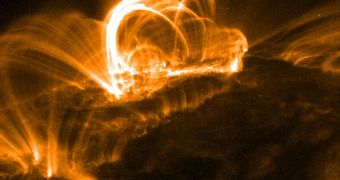The heat wave that struck the US and Europe has made NASA keep a close eye on the sun, in an effort to predict future events, since these weather extremes are happening despite the fact that solar activity is at minimum.
For now, the Sun is almost spotless, marking the solar minimum, one of two major characteristics of the solar cycle. During this time sunspot and solar flare activity diminishes and often does not occur for days at a time.
Astronomers are watching closely for the appearance of the new sunspots, which mark the Sun's entry into a new season of extreme solar activity. At the cycle's peak, solar maximum, the sun is continually peppered with spots, solar flares erupt and the sun hurls billion-ton clouds of electrified gas into space.
Every 11 years, the Sun experiences a period of massive solar storms, when violent solar flares and vast explosions known as Coronal Mass Ejections (CME) have the strongest manifestations of the entire cycle.
A solar flare is a violent explosion in the Sun's atmosphere with an energy equivalent to a billion megatons, traveling normally at about 1 million km per hour (about 0.05% the speed of light), though sometimes much faster. The flares have been known to affect the electro transmission of many earthly communication devices including computers, cell phones, pagers, GPS and automobiles.
Solar flares take place in the solar corona and chromosphere, heating plasma to tens of millions of kelvins and accelerating the resulting electrons, protons and heavier ions to near the speed of light and hurling them into space.
The fact that the solar storms cycle is one year late has troubled some astronomers and they are wondering if this means that a weak or strong period of solar storms lays ahead, but neither predicts a record-breaker.

 14 DAY TRIAL //
14 DAY TRIAL //